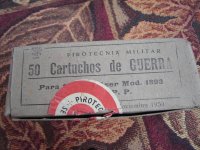I have shot a lot of Mauser rifles, chambered in all sorts of calibers. It may be that the ammo you have is not corrosive. Cool. It may be that the ammo you have is corrosive. Cool. Corrosive or non-corrosive is just not a big deal. Shoot the ammo in your rifle. If you can do so at the range, put a few drops of Windex on a patch and wipe out the barrel. Then follow with an oiled patch. Upon arriving home, put a pot of water on the stove to boil. Put a squirt of dishwashing liquid in the water. When it is boiling, put the pot of water on the floor. Put a cleaning patch on a jag and run it down the barrel to the muzzle. Place the muzzle in the hot water and "pump" it up the barrel. The patch will get wet and form and effective piston. The scalding hot water will completely eliminate any possible corrosive residue in the barrel. It will get the barrel and chamber so hot that when you are finished, the heat will completely dry the metal. If you need to deal with copper fouling, follow with something like Shooters Choice and a phosphor-bronze bore brush. Finish by running a oily patch through the chamber and bore. I've used this method to clean after shooting corrosive ammo in my rifles. I've not ever had a single problem with my rifles.

